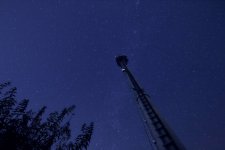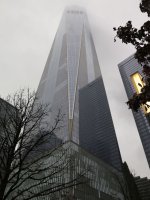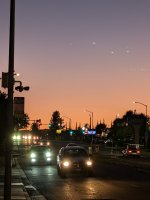Ah, not quite accurate. If (I'll grant you that's a big IF) kept frozen, film lasts surprisingly well. I've got multiple rolls of Kodak Ektachrome 100 plus in 220 format dated 08/2007. I've given rolls to a close friend who has shot them at an ISO of 80. (Now, normally with transparency film like that, I'd expose at 120 ISO, so there's compensation for speed loss) He's had them developed and the image quality is outstanding.Unfortunayely film - especially color film - is not like wine: instead of improving, after the deadline...
c
Cheers X . I love walking around NYC. Every day is exciting; at least around Christmas time! Unfortunately that winter was quite warm and we missed the snow we hoped would come.
One shot I missed was Macauley Culkin looking really disheveled coming out of a bottle shop with a bottle of spirits in his hand. It was on a wet cobbled road in the half light reflecting down the narrow cobblestone street and would have been quite evocative as he trudged away from us, head down (behind shot), but I didn't take it out of respect for the guy's privacy. We didn't show we'd recognised him as he walked past.
One shot I missed was Macauley Culkin looking really disheveled coming out of a bottle shop with a bottle of spirits in his hand. It was on a wet cobbled road in the half light reflecting down the narrow cobblestone street and would have been quite evocative as he trudged away from us, head down (behind shot), but I didn't take it out of respect for the guy's privacy. We didn't show we'd recognised him as he walked past.
Last edited:
If (I'll grant you that's a big IF) kept frozen.
Yes, IF. pros (me included) used to check an emulsion batch - even if for film sheets kodak gave the filtering to start with - and bought a quantity for an year or two, and kept them in a freezer. If stored on a store shelf, as commonly usual, after the expiration date the behavior became more and more unreliable.
So after 20 years ... great for creative results.
c
Yes, IF. pros (me included) used to check an emulsion batch - even if for film sheets kodak gave the filtering to start with - and bought a quantity for an year or two, and kept them in a freezer. If stored on a store shelf, as commonly usual, after the expiration date the behavior became more and more unreliable.
So after 20 years ... great for creative results.
c
I didn’t keep my 3 rolls of Kodak B&W 400 or 2 rolls of Fuji 400 NPH 120 in the refrigerator all these years. So, I think they are now going to be officially “artsy” film stock. 😂
My collection of cameras (missing is a Canon S50 P&S that I can’t find).

Clockwise from left: Nikon FM2, Nikon FE, Bronica S2A, Nikon Z6II, Canon A640, Konica Auto S3, Nikon 35Ti, Panasonic GX1, and Konica Auto S in middle.
The Canon A640 has a lens cover that doesn’t fully close. But it is the only one with a CCD technology sensor and renders beautiful color images at 10Mpix.
The 35Ti was a present from my wife back in 2000. I think it’s the one camera that has gone up in value after purchase.
My collection of cameras (missing is a Canon S50 P&S that I can’t find).
Clockwise from left: Nikon FM2, Nikon FE, Bronica S2A, Nikon Z6II, Canon A640, Konica Auto S3, Nikon 35Ti, Panasonic GX1, and Konica Auto S in middle.
The Canon A640 has a lens cover that doesn’t fully close. But it is the only one with a CCD technology sensor and renders beautiful color images at 10Mpix.
The 35Ti was a present from my wife back in 2000. I think it’s the one camera that has gone up in value after purchase.
Last edited:
I've been looking into this Monochrome conversion thing. The question is do I try it myself? Prices are based on replacement of a camera it seems like, so not cheap. But the results are incredible. They make a smaller sensor resolve like a fullframe. You can however do fullframe Sony's easily through a guy that does them.
Removing all the fluff on top of the sensor is like 4x ing or better the resolution when zooming in on stuff.
Removing all the fluff on top of the sensor is like 4x ing or better the resolution when zooming in on stuff.
Is that why surveillance photos are always portrayed as being monochrome?
Sorry, I had to. 😀 But to make up for it I found this cool video:
Sorry, I had to. 😀 But to make up for it I found this cool video:
Last edited:
Superb 👍The Vessel in NYC taken with iPhone 12.
View attachment 1396134
View attachment 1396135
View attachment 1396136
One WTC poking into the clouds:
View attachment 1396137
Is that why surveillance photos are always portrayed as being monochrome?
Sorry, I had to. 😀 But to make up for it I found this cool video:
Monochrome devices gain a stop or better and some of those devices have infrared lights that they also capture. Much cheaper than "night vision" of the light magnification type.
Thanks. I think one of the greatest improvements with the iPhone as a camera is the ability to handhold long night time exposures. Maybe this exists on newer digital cameras but sometimes the shots are like 5 seconds long and I think the iPhone averages many dozens of images to get the nice signal to noise. But strange how it’s not blurry.Superb 👍
The other thing that is very cool is the panoramic sweep mode - when doing a Tall vertical panorama it can generate interesting perspective distortion effects.
All these shots were handheld and no flash. Yet they are well exposed and sharp. Amazing results for non specialized equipment.
Last edited:
I just got a Pixel 8 Pro this summer and I'm amazed how easy it is to take photos with it. This picture was a handheld snapshot without any manual settings. One take and no post processing. At least, by me. I'm sure Mr. Google did a lot of magic.
Attachments
Yes - I use the pano a lot and for doing shots of tall trees and buildings as well. The iPhone has come on leaps and bounds over the last few years. My daughter-in-law takes some incredible shots of the grandson - decent bokeh, the works. I think as the software and DSP improves, the capability will only get better.Thanks. I think one of the greatest improvements with the iPhone as a camera is the ability to handhold long night time exposures. Maybe this exists on newer digital cameras but sometimes the shots are like 5 seconds long and I think the iPhone averages many dozens of images to get the nice signal to noise. But strange how it’s not blurry.
The other thing that is very cool is the panoramic sweep mode - when doing a Tall vertical panorama it can generate interesting perspective distortion effects.
View attachment 1404360
All these shots were handheld and no flash. Yet they are well exposed and sharp. Amazing results for non specialized equipment.
As far as I know:But strange how it’s not blurry.
The trick is that the camera takes lots of short shutter non-blurry images and realigns them to counteract the handheld shaking before averaging to get a low noise high sharpness photo.
This is also common in astro-photography, where you need to account for stars moving because of earth rotation.
I did it fot the attached photo. Of course some further tweaking was necessary, because of non-moving elements!

Last edited:
I took my Z6II and the old 50mm F/1.2 AIS manual focus lens to take action shots of climbing today. The MF lens worked amazingly well because it allowed me to capture the “decisive moment” without shutter lag from autofocus (as fast as it is nowadays). The 50mm was the perfect perspective and renders beautifully with a modern mirrorless 24Mpix camera. Shot at F/2.0 for optimum sharpness and high shutter speed, ISO1600. Amazing how this lens stands the test of time. Much more compact than a modern 50mm F/1.2 S lens.
Rig looks like this with HS-9 hood:

I am very happy with how this combo worked out and will be carrying this as my EDC for a while now.


Rig looks like this with HS-9 hood:
I am very happy with how this combo worked out and will be carrying this as my EDC for a while now.
Last edited:
The 50mm F/1.4 Z is a keeper! ISO 1600, 1/1600sec, at F/1.4 (wide open). This is downsampled from the 24Mpix image. I like the rendering and smoothness of the out of focus regions. The color is wonderful. Nikon Z lenses are superb.

Here is a crop showing the sharpness - you can see individual stitching and threads on the harness.

Here is a crop showing the sharpness - you can see individual stitching and threads on the harness.
That's very nice. Shallow depth of field takes some intense reckoning to get right when the scene is moving.
I'm still very confused by the "Active D-lighting" feature on my D3200 even though I manually draw the tone curve for most of the photos I care about. There really is no understandable nuts and bolts description of what it does, just vague impressions and no sure explanation of how it affects RAW images.
https://photo.stackexchange.com/questions/37958/should-i-use-active-d-lighting-when-shooting-raw
As long as there is a low level of noise and nothing dreadfully overexposed, I am fine with doing manual tone curve. But if I use any of the auto settings on this camera, everything comes out noisy. It mystifies me that Nikon chooses to maximize exposure at the expense of dynamic range. Anything over 200ISO on this camera doesn't seem to be worth it. I understand that film noise is part of the art, but I don't want it in every image.
I'm still very confused by the "Active D-lighting" feature on my D3200 even though I manually draw the tone curve for most of the photos I care about. There really is no understandable nuts and bolts description of what it does, just vague impressions and no sure explanation of how it affects RAW images.
https://photo.stackexchange.com/questions/37958/should-i-use-active-d-lighting-when-shooting-raw
As long as there is a low level of noise and nothing dreadfully overexposed, I am fine with doing manual tone curve. But if I use any of the auto settings on this camera, everything comes out noisy. It mystifies me that Nikon chooses to maximize exposure at the expense of dynamic range. Anything over 200ISO on this camera doesn't seem to be worth it. I understand that film noise is part of the art, but I don't want it in every image.
if you are handy with Python, you can read a Nikon NEF file into 24bit RGB pixel data frames in 5 lines of code. You can manipulate the pixels exactly like you want and batch process it.
https://imagepy.wordpress.com/2015/11/21/raw-image-processing-in-python-an-example/
Also lots of stuff on Stack Overflow and GitHub.
https://stackoverflow.com/questions/2422050/raw-image-processing-in-python
As far as Active D lighting - here is what ChatGPT said:
https://imagepy.wordpress.com/2015/11/21/raw-image-processing-in-python-an-example/
Also lots of stuff on Stack Overflow and GitHub.
https://stackoverflow.com/questions/2422050/raw-image-processing-in-python
As far as Active D lighting - here is what ChatGPT said:
Nikon’s Active D-Lighting (ADL) is a feature designed to optimize the exposure and dynamic range in your photos. It enhances details in both the highlights (bright areas) and shadows (dark areas) by balancing the contrast during image capture. Here’s how it works and when it’s beneficial:
How It Works:
1. Dynamic Range Adjustment:
• Active D-Lighting applies tone curves to the image during processing to retain detail in bright and dark areas.
• It prevents overexposure in highlights and lifts shadows without flattening the image entirely.
2. Real-Time Processing:
• Unlike post-processing, ADL adjusts the image as it is being taken, based on the scene’s lighting conditions.
• It works by tweaking the exposure settings and applying in-camera processing.
3. Multiple Levels:
• ADL often has intensity levels like Low, Normal, High, Extra High, or even Auto, allowing photographers to choose how much correction they want.
When to Use It:
• High-Contrast Scenes:
• Ideal for landscapes with bright skies and dark foregrounds or interiors with strong backlighting.
• Backlit Subjects:
• Useful for portraits where the subject is illuminated from behind.
• Preserving Details:
• Keeps fine details visible in bright highlights and deep shadows.
How It Differs From HDR:
• Active D-Lighting modifies a single exposure, whereas HDR (High Dynamic Range) combines multiple exposures for greater tonal range.
• ADL is quicker and doesn’t require a tripod or multiple shots, making it more practical for dynamic situations.
Impact on RAW and JPEG:
• For JPEG images, ADL adjustments are applied directly to the file.
• For RAW (NEF) files, the adjustments are noted as metadata and can be tweaked further in Nikon’s editing software like NX Studio.
Drawbacks:
• May introduce noise in shadows if overused.
• Can slow down continuous shooting in some camera models due to additional processing.
Active D-Lighting is especially helpful for photographers who want well-balanced images straight out of the camera, reducing the need for extensive editing afterward.
Last edited:


